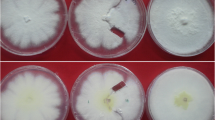Abstract
Isolates ofTyphula ishikariensis, a snow mold fungus, were collected from five localities in Norway. They were divided into three groups according to genetics, cultural morphology, etc. Group I grew normally at 10 °C. Its mating patterns with Japanese taxa were variable: compatible with both biotypes A and B; compatible with biotype A but incompatible with biotype B; and incompatible with both biotypes. Group I was prevalent in southern inland districts such as Buskerud, Oppland, and Hedmark. Group II had smaller sclerotia as compared to other groups, and its sclerotia were often covered with white mycelium in nature and in culture. Group II was compatible with biotype B only. Group III was characterized by irregular growth at 10 ° C and genetic incompatibility with biotypes A and B. Cultural morphology of group III resembled that of group I at 0 °C. Rind cell patterns of sclerotia did not separate these two groups or biotypes. Isolates of groups II and III were often obtained from coastal regions in Finmark. Mating reactions were variable: monokaryons were compatible with their respective dikaryons, and monokaryons of groups II and III occasionally mated with group I dikaryons. Dikaryons of groups II and III, however did dikaryotize monokaryons of other groups. Norwegian isolates ofT. ishikariensis were highly variable, and the orthodox nomenclature system seemed inapplicalbe at the infraspecific level.
Similar content being viewed by others
References
Årsvoll K (1973) Winter damage in Norwegian grasslands, 1968–1971. Meld. Norg. LandbrHøgsk. 56(28) 14 pp
Årsvoll K and Smith JD (1978)Typhula ishikariensis and its varieties, var.idahoensis comb. nov. and var.canadensis. Can. J. Bot. 56: 348–364
Bruehl GW and Cunfer BM (1975)Typhula species pathogenic to wheat in the Pacific Northwest. Phytopathology 65: 755–760
Bruehl GW, Machtmes R, and Kiyomoto R (1975) Taxonomic relationships amongTyphula species as revealed by mating experiments. Phytopathology 65: 1108–1114
Bruehl GW and Machtmes R (1980) Cultural variation withinTyphula idahoensis andT. ishikariensis and the species concept. Phytopathology 70: 867–871
Christen AA and Bruehl GW (1979) Hybridization ofTyphula ishikariensis andT. idahoensis. Phytopathology 69: 263–266
Ekstrand H (1955) Höstsädens och vallgräsens övervintring. Meddeland. Statens Växtskyddanst. 67, 125 pp
Honkura R, Matsumoto N, and Inoue T (1986)Typhula ishikariensis biotype C, a snow mold fungus, can complete its life cycle without snow cover. Trans. Mycol. Soc. Japan 27: 207–210
Matsumoto N (1992) Evolutionary ecology of the pathogenic species ofTyphula. Trans. Mycol. Soc. Japan 33: 269–285
Matsumoto N (1995) Ecological adaptations of low temperature plant pathogenic fungi to diverse winter climates. Can. J. Plant Pathol. 16: 237–240
Matsumoto N and Tajimi A (1990) Continuous variation within isolates ofTyphula ishikariensis biotypes B and C associated with habitat differences. Can. J. Bot. 68: 1768–1773
Matsumoto N and Tajimi A (1991)Typhula ishikariensis biotypes B and C, a single biological species. Trans. Mycol. Soc. Japan 32: 273–281
Matsumoto A and Tronsmo AM (1995) Population structure ofTyphula ishikariensis in meadows and pastures in Norway. Acta Agric. Scand. Sect. B, Soil and Plant Sci. 45: 197–201
Matsumoto N, Sato T, and Araki T (1982) Biotype differentiation in theTyphula ishikariensis complex and their allopatry in Hokkaido. Ann. Phytopath. Soc. Japan 48: 275–280
Matsumoto N, Sato T, Araki T, and Tajimi A (1983) Genetic relationships within theTyphula ishikariensis complex. Trans. Mycol. Soc. Japan 24: 313–318
Sinadskii YB and Tkachenko OB (1981) Corrective to the taxonomic position of Typhula blight of tulips. Mycology and Phytopathology 15: 423–425 (in Russian)
Smith JD (1987) Winter-hardiness and overwintering diseases of amenity turfgrasses with special reference to the Canadian Prairies. Tech. Bull. 1987-12E, Agriculture Canada, 193 pp
Author information
Authors and Affiliations
Rights and permissions
About this article
Cite this article
Matsumoto, N., Tronsmo, A.M. & Shimanuki, T. Genetic and biological characteristics ofTyphula ishikariensis isolates from Norway. Eur J Plant Pathol 102, 431–439 (1996). https://doi.org/10.1007/BF01877137
Accepted:
Issue Date:
DOI: https://doi.org/10.1007/BF01877137




